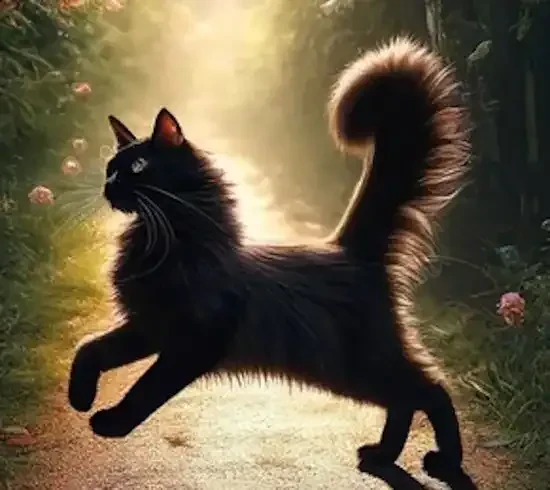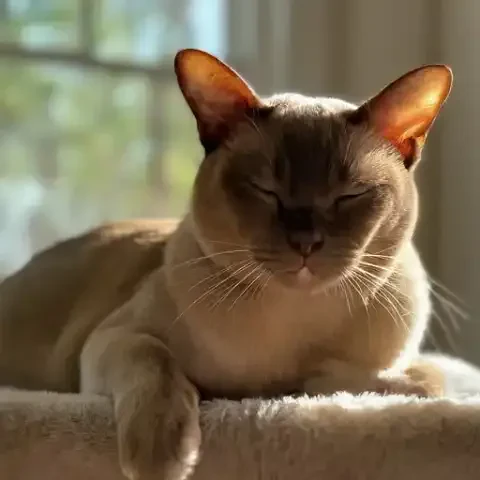Picture a sleek, panther-like creature gliding silently across a moonlit garden, its shadow merging seamlessly with the darkness. Or perhaps imagine a pair of luminous eyes, like twin embers, suddenly appearing from the inky blackness beneath a sofa. For centuries, black cats have captivated and confounded us, their very presence sparking a strange blend of fascination and trepidation. They are creatures draped in mystery, cloaked in folklore, simultaneously adored and avoided. This dichotomy, this strange dance between allure and apprehension, lies at the heart of the enigmatic charm of black cats.
From Halloween decorations to spooky imagery, black cats are deeply embedded in our cultural consciousness, often portrayed as harbingers of bad luck, familiars of witches, or symbols of misfortune. Yet, alongside these negative associations, there exists an undeniable magnetism, an intriguing mystique that draws us to them. There is a reason why they feature so prominently in tales of magic and mystery, why their image evokes a sense of the unknown, a whisper of something just beyond our grasp.
This article aims to unravel the “mysterious charm” of black cats, to delve beyond the outdated and often damaging superstitions that have clung to them like shadows. We will explore the historical roots of these myths, dissect their real-world impact, and, most importantly, reveal the reality of these magnificent creatures, celebrating their unique beauty, captivating personalities, and enduring allure. It’s time to step out of the darkness of superstition and into the light of understanding, to appreciate the true charm that black cats offer, a charm that has been obscured for far too long.
The chilling winds of superstition surrounding black cats have their roots deeply entangled in the fertile, yet often fearful, soil of history. To understand the persistent negative myths, we must journey back to medieval times, an era steeped in religious fervor and societal anxieties. During this period, the cat, already somewhat enigmatic in its independent nature, became increasingly demonized, particularly when adorned in black fur. The rise of Christianity in Europe saw a suppression of pagan beliefs, and symbols once associated with pre-Christian religions were reinterpreted as tools of the devil. Cats, being nocturnal and often independent, were linked to witchcraft and paganism, and black cats, with their shadowy appearance, became potent symbols of the dark arts.
The association with witchcraft solidified during the witch hunts of the Middle Ages and the early modern period. Black cats were believed to be the “familiars” of witches, demonic spirits disguised in feline form, sent to do their mistress’s bidding or even serve as the witch’s alter ego. Stories circulated of witches transforming into black cats, further blurring the lines between human evil and feline form. These terrifying tales, fueled by fear and misunderstanding, spread throughout Europe and eventually to other parts of the world, embedding the image of the black cat as a symbol of bad luck and malevolence deep within the collective psyche.
While the intensity of witch hunts has faded, the echoes of these superstitions reverberate even today. Walk under a ladder, break a mirror, or have a black cat cross your path – each action, according to ingrained folklore, can invite misfortune. The myth of the black cat crossing your path, particularly, remains remarkably persistent. It is said that if a black cat crosses your path, bad luck is imminent, though the direction sometimes dictates the severity. Crossing from left to right is often deemed especially ominous in Western cultures, while in some parts of Scotland and Japan, a black cat crossing your path is considered a harbinger of good fortune. This variation itself highlights the arbitrary nature of superstition; the same creature can be both a blessing and a curse depending on geographical location and cultural interpretation.
Beyond the path-crossing omen, other pervasive myths continue to paint black cats in a negative light. They are often associated with death, misfortune, and general ill-omen. They are staples in Halloween decorations, typically alongside skeletons and ghouls, reinforcing their association with spooky and sinister themes. This constant barrage of negative imagery and folklore has a tangible and heartbreaking impact on real black cats. Animal shelters and rescue organizations consistently report that black cats are adopted at lower rates compared to cats of other colors. They often spend longer periods in shelters, and tragically, statistics indicate that black cats are euthanized at higher rates than cats of other coat colors. This phenomenon, sometimes referred to as “Black Cat Bias” or “Black Cat Syndrome,” is a grim testament to the power of ingrained superstition in the modern world. These are not creatures of bad luck, but creatures unlucky enough to be burdened by centuries of unfounded fear and prejudice. It’s a shadow cast not by their own actions, but by the long, dark shadow of human superstition. It's time to step out from under this shadow and into the light, to see the real cat beneath the inky fur.
To truly appreciate the charm of black cats, we must dismantle the flimsy framework of superstition and replace it with the solid foundation of reality. The most fundamental truth, often lost amidst the whispers of folklore, is that a black coat is simply a genetic trait. The ebony fur, the glossy sheen, the midnight elegance - all stem from variations in genes responsible for coat color. It's no more a sign of malevolence than having red hair or blue eyes in humans. Melanin, the same pigment that colors human hair and skin, is responsible for the dark hue in black cats. Specific genetic mutations lead to a higher concentration of eumelanin, resulting in the stunning black coat we admire. It’s biology, not black magic.
Furthermore, black cats are, first and foremost, cats. They are individuals, each with their own unique personality, quirks, and preferences. Just as you wouldn't assume all tabby cats are lazy or all ginger cats are feisty, it's illogical and unfair to stereotype black cats based on their coat color. To believe that all black cats share a sinister personality is akin to believing all people with brown eyes are the same. Personality in cats, just like in humans and other animals, is a complex tapestry woven from genetics, upbringing, environment, and individual experiences. Coat color plays absolutely no role in determining whether a cat will be affectionate, playful, shy, or bold.
Indeed, anecdotal evidence from countless black cat owners paints a picture that starkly contrasts with the superstitious narrative. Veterinarians and shelter workers, who interact with cats of all colors daily, often report that black cats are no different, and often even exceptionally friendly and affectionate. Many black cat devotees describe their ebony companions as incredibly loving, playful, intelligent, and even talkative. Personal stories abound of black cats being devoted lap cats, enthusiastic playmates, and comforting companions during times of stress or loneliness. These are not tales of shadowy familiars, but heartwarming accounts of the deep bonds that humans share with their black feline friends.
Beyond their individual personalities, black cats possess a visual elegance that is undeniable. Their sleek, glossy fur lends them a “mini-panther” aesthetic, a wild beauty contained within a domestic frame. The black coat, far from being simply a void of color, is a canvas that accentuates other striking features. The contrast between the deep black fur and the often vibrant eye color – ranging from striking gold to mesmerizing emerald green – is particularly captivating. These luminous eyes seem to pierce the darkness, adding to their mystique in a way that is purely visual, purely aesthetic, and utterly charming.
Moreover, their dark fur provides a camouflage advantage, though primarily within our homes rather than the wild. A black cat lounging in a dimly lit room can become almost invisible, a playful master of stealth, adding to their enigmatic presence. This ability to blend into shadows can be seen not as sinister, but as graceful, adding a layer of intrigue to their movements and enhancing their already mysterious aura. It's a beauty inherent in their appearance, a natural elegance that has nothing to do with superstition and everything to do with the inherent artistry of nature. When we look beyond the lens of fear and folklore, we see not an omen of ill tidings, but a creature of undeniable beauty, a testament to the elegant simplicity of the natural world.
Moving further beyond the physical, we arrive at the realm of personality traits, another area where black cats have been unfairly subjected to baseless stereotypes. The myth-fueled perception that black cats are somehow "different" personality-wise – perhaps more aloof, aggressive, or less affectionate – is completely unfounded. As repeatedly emphasized, personality in cats is individual, not dictated by coat color. There is no scientific basis to suggest that the genes responsible for black fur are linked to any specific personality traits.
However, while it’s crucial to avoid generalizations, some interesting anecdotal observations and emerging research, while not conclusive, do hint at certain personality tendencies sometimes observed in black cats. It is important to stress that these are tendencies, not hard and fast rules, and individual variation remains paramount. Some studies exploring feline genetics and behavior have suggested potential links between certain genes associated with black coat color and calmer temperaments in specific breeds. For example, some preliminary research suggests that black cats within breeds like the Bombay or black Persians, may exhibit a slightly higher predisposition towards calmer, more docile personalities. However, this is still a nuanced and developing area of research, and it’s crucial to avoid overstating or misinterpreting these findings.
More broadly, and again anecdotally, many black cat owners consistently describe their feline companions as remarkably affectionate, playful, and intelligent. They are often portrayed as particularly attuned to their owners’ emotions, acting as comforting and supportive companions. Some even describe their black cats as more “talkative” or communicative, engaging in vocalizations and interactions more frequently than cats of other colors – although this could simply be heightened awareness due to their striking visual presence. These positive personality traits, repeatedly observed and cherished by black cat lovers, directly challenge the negative stereotypes perpetuated by superstition.
The “mysterious” aspect often associated with black cats, when reframed, becomes a core element of their charm. It's not a sinister mystery, but an intriguing allure, a captivating enigma that draws us in. Their sleek black appearance, while once demonized, now lends them an air of elegance and sophistication. They possess a quiet grace, a stillness in their presence that can be incredibly calming and captivating. Their ability to blend into shadows, once seen as ghostly or malevolent, can be reinterpreted as a graceful fluidity, a mysterious presence that invites curiosity rather than fear.
The very darkness of their fur becomes a canvas for contrast, enhancing other features and amplifying their charm. Their vibrant eyes, whether gold or green, seem to blaze more brightly against the backdrop of their black fur. Their playful movements, a sudden dart across a sunlit room, become all the more striking, the flash of black fur against a lighter background catching the eye and sparking delight. The “mystery” they embody is not one of ill-omen, but of quiet contemplation, of hidden depths, of an unspoken elegance that invites deeper connection.
Beyond aesthetics and enigmatic allure, lies the profound reality of personal connection and companionship. Stripped of superstition, black cats are simply loving creatures, capable of forming deep and meaningful bonds with their human families. They offer the same comfort, affection, and unwavering loyalty as any other cat. They purr on laps, knead with gentle paws, and offer silent companionship during quiet moments. They are playful partners, entertaining us with their antics and showering us with affection. They are confidantes, offering silent support and non-judgmental presence.
Countless stories attest to the deep bonds people share with their black cats. They are described as sensitive souls, intuitively understanding their owners’ moods, offering comfort during sadness and celebrating moments of joy with playful nudges and purrs. They are not creatures of myth and legend, but warm, breathing, loving companions who enrich our lives in countless ways. The true charm of black cats lies not in some mystical or superstitious quality, but in the simple, profound, and utterly beautiful reality of their companionship. They are, at their heart, cats – and like all cats, they offer a unique and irreplaceable form of love and connection that transcends coat color and defies outdated fears.
Even within the realm of pop culture, where black cats are often deployed as symbols of Halloween and spookiness, a more nuanced and often more positive representation is beginning to emerge. While traditional media often leans into the negative stereotypes, utilizing black cats for jump scares and ghostly imagery, there is a growing trend towards more playful and even celebratory portrayals. Consider Salem Saberhagen from Sabrina the Teenage Witch, a black cat with a sardonic wit and a mischievous, yet ultimately loyal, personality. While still associated with magic, Salem subverts the purely sinister stereotype, becoming a comedic and beloved character.
Internet culture, in particular, has played a significant role in reclaiming the image of the black cat. Countless adorable black cat videos and memes circulate online, showcasing their playful nature, endearing quirks, and sheer charm. Social media platforms are flooded with images of sleek, glossy black cats lounging in sunbeams, engaging in silly antics, and being utterly adored by their owners. This online representation, while sometimes still playful with the “mysterious” trope, largely shifts the narrative towards positivity and appreciation, showcasing the reality of black cats as beloved pets and companions. Pop culture, therefore, acts as a double-edged sword, both perpetuating old stereotypes and, increasingly, offering avenues for subversion and positive reinterpretation. It is through these shifting portrayals, coupled with real-world experience, that perceptions can begin to change.
Ultimately, dismantling ingrained superstitions requires active advocacy and a conscious shift in perspective. October and November, designated as Black Cat Awareness Month and Black Cat Appreciation Day respectively, offer valuable platforms to highlight the plight of black cats in shelters and promote their adoption. These initiatives encourage shelters and rescue organizations to run adoption specials, disseminate information debunking myths, and celebrate the unique beauty and charm of black cats.
For individuals, the call to action is clear: reconsider your perceptions of black cats. Visit local shelters, meet black cats firsthand, and experience their individual personalities. Dispel the myths to others, share positive stories and images online, and challenge negative portrayals whenever you encounter them. Consider opening your heart and home to a black cat in need. Practical steps can also include supporting black cat rescue organizations, volunteering at shelters, and advocating for black cat adoption within your community.
Perhaps the true mystery of black cats isn't bad luck, but the centuries of misunderstanding that have obscured their inherent charm and the unwavering love they offer. They are not creatures of bad omen, but creatures of elegance, grace, and profound companionship. Let us finally embrace their enigmatic allure, not with fear, but with open hearts and a clear vision, recognizing the beauty, the personality, and the pure, unadulterated charm that resides within these magnificent midnight creatures. For in their glossy black fur, in their luminous eyes, and in their gentle purrs, lies not darkness, but a unique and captivating light, a testament to the enduring magic of the feline spirit.







